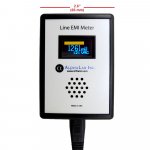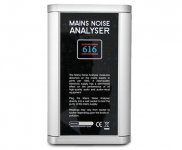anyone measured his line conditioner with an Isotek Blue Horizon or Alphalabs PLM and can share values with/without the conditioner/filter?
(DIY and/or commercial)
Perhaps also additional full spectrum shots?
(DIY and/or commercial)
Perhaps also additional full spectrum shots?
Attachments
Wow.....100 views and no one with data?
DIY Audio with builders that make line filters/conditioners without measuring?
Can't be true, right?
DIY Audio with builders that make line filters/conditioners without measuring?
Can't be true, right?

It might be true that nobody has Isotek Blue Horizon or Alphalabs PLM mains noise analysers.....do you ?.
Dan.
Dan.
Yep, alphalabs here...and freeware spectrum SW (limited to 20kHz unfortunately, hence searching for other "partners in crime")
But then again....I would expect designers to verify what they made (beyond checking that the output voltage is ok)
But then again....I would expect designers to verify what they made (beyond checking that the output voltage is ok)
Safely connecting a spectrum analyser to the mains in order to get meaningful measurements is not easy, so perhaps it is good that few attempt it.
Then the attenuation achieved by a filter depends on the attached load, so there are lots of variables. Difficult to get helpful figures, although getting a number from a meter may satisfy some people.
Then the attenuation achieved by a filter depends on the attached load, so there are lots of variables. Difficult to get helpful figures, although getting a number from a meter may satisfy some people.
Wow.....100 views and no one with data?
DIY Audio with builders that make line filters/conditioners without measuring?
Can't be true, right?
You assume that everyone who views your thread makes line filters?
🙄
I thought reading the title he/she might have something to offer......turns out he/she's a demanding drama queen 😉🙂
Safely connecting a spectrum analyser to the mains in order to get meaningful measurements is not easy, so perhaps it is good that few attempt it.
Then the attenuation achieved by a filter depends on the attached load, so there are lots of variables. Difficult to get helpful figures, although getting a number from a meter may satisfy some people.
Correct, a safe start is connecting a 12V adapter to get the first indications....this is the reason for starting the topic to see if any DIY-er explored this in a better way ...
Let's wait a bit if the person with that experience steps up, otherwise topic can be closed
Cheers
Arno
Correct, a safe start is connecting a 12V adapter (and attenuating resistor string) to get the first indications....this is the reason for starting the topic to see if any DIY-er explored this in a better way ...
Let's wait a bit if the person with that experience steps up, otherwise topic can be closed
Cheers
Arno
Hi Arno. 12V transformer connected soundcard ADC 20kHz bandwidth should tell you something useful about 240V line noise pre and post line filter.
Another place to look would be across PSU DC rails...you will need to AC (capacitor) couple soundcard input. A suitable solenoid (relay) coil and audio ADC will tell you about radiated emissions within audio bandwidth.
Another directional and sensitive sniffer coil is to connect a car cylindrical type ignition coil to portable amplifier/speaker and take a listen....you might be surprised at the level of power line (and harmonics) magnetic disturbance in the typical environment. Try holding such a coil at your listening position and aimed at one of the loudspeakers inline with the bass driver polepiece/dustcap....the result is interesting if not alarming !.
Dan.
Another place to look would be across PSU DC rails...you will need to AC (capacitor) couple soundcard input. A suitable solenoid (relay) coil and audio ADC will tell you about radiated emissions within audio bandwidth.
Another directional and sensitive sniffer coil is to connect a car cylindrical type ignition coil to portable amplifier/speaker and take a listen....you might be surprised at the level of power line (and harmonics) magnetic disturbance in the typical environment. Try holding such a coil at your listening position and aimed at one of the loudspeakers inline with the bass driver polepiece/dustcap....the result is interesting if not alarming !.
Dan.
Last edited:
SJ, is this kind of comment really necessary....please desist.I thought reading the title he/she might have something to offer......turns out he/she's a demanding drama queen 😉🙂
Dan.
To hear such an "alarming" signal you may put your fingers on the tip of a guitar cable with the amp gain fully cranked up as well.Try holding such a coil at your listening position and aimed at one of the loudspeakers inline with the bass driver polepiece/dustcap....the result is interesting if not alarming !.
Dan.
50/60Hz fields everywhere! 😛
SJ, is this kind of comment really necessary....please desist.
Dan.
Sorry Dad, I mean, Dan
Stupid comment in the context of this thread. My point was to inform the OP and the rest of you that when sitting in your listening chair with both loudspeakers aimed directly at the listening 'sweetspot', the listener is placed at the intersection of two modulated magnetic 'beams'.....I believe this is not healthful, just sayin'.To hear such an "alarming" signal you may put your fingers on the tip of a guitar cable with the amp gain fully cranked up as well.
50/60Hz fields everywhere! 😛
Dan.
Hi Arno. 12V transformer connected soundcard ADC 20kHz bandwidth should tell you something useful about 240V line noise pre and post line filter.
Another place to look would be across PSU DC rails...you will need to AC (capacitor) couple soundcard input. A suitable solenoid (relay) coil and audio ADC will tell you about radiated emissions within audio bandwidth.
Another directional and sensitive sniffer coil is to connect a car cylindrical type ignition coil to portable amplifier/speaker and take a listen....you might be surprised at the level of power line (and harmonics) magnetic disturbance in the typical environment. Try holding such a coil at your listening position and aimed at one of the loudspeakers inline with the bass driver polepiece/dustcap....the result is interesting if not alarming !.
Dan.
Indeed, transformer-trick already shows a lot in combination with the alpha lab there even seems to be some correlation 🙂....but the 20kHz can only highlight a possible trend that might proceed in the MHZ range (that is out of range).. Sniffers and stuff, I am familiar in the world of EMC design and measurement...and yes it can be rather revealing..
What I would really like to see is the alphalab/blue horizon of commercial conditioners....just have an idea of reference. Isotek does this for some units, but it would be great if a forum member owns one of them commercial conditioners and could give such data...with and without load on the filter.
On my workbench I got a filter that drops an incoming noise level of 180-260mV to 22mV ...and it hardly changes when un/loaded. In a wrong design there will be vast differences between loaded/unloaded (due to resonance/interaction of the used components LC)...
So, still curious about more commercial unit data (which seems not to be logical to include in every review)
Pretty cool testers, but those analyzers cost 10X what I have into my line level effort.
I will just have to be happy with what I hear for now anyways...
I will just have to be happy with what I hear for now anyways...
If it doesn't show up on the low pass filtered DC power supply rails or come out of the limited bandwidth amplifier and I can't hear it from the limited bandwidth speakers I don't do anything at all to condition my power. Never have. This in my opinion is a great way for audiophile stores to sell more stuff you can't possibly hear a difference with in a double blind test. If you want to be super fancy toss a ferrite bead on your power cord and call it good.
my comment was intentionnally stupid, and yours?Stupid comment in the context of this thread.
My point was to inform the OP and the rest of you that when sitting in your listening chair with both loudspeakers aimed directly at the listening 'sweetspot', the listener is placed at the intersection of two modulated magnetic 'beams'.....I believe this is not healthful, just sayin'.
Dan.
Last edited:
Informative.my comment was intentionnally stupid, and yours?
Dan.
- Status
- Not open for further replies.
- Home
- Amplifiers
- Power Supplies
- Line conditioner measurements


